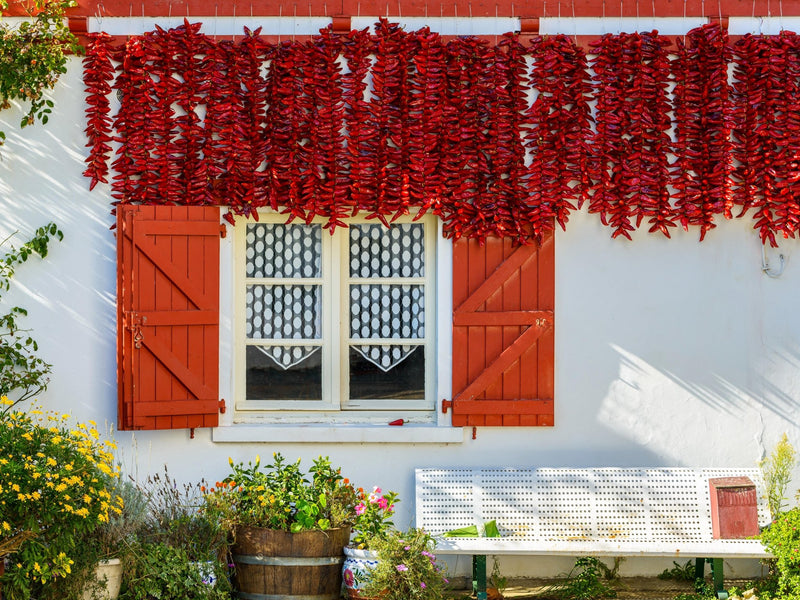
We were privileged to visit Espelette, France, to source our renowned Piment d'Espelette, bringing you the finest quality and authenticity straight from its origin.
The Basque region, located in the western Pyrenees along the border of France and Spain, is known for its rich culture, history, and traditions. The region has a renowned culinary tradition, with a focus on fresh, local ingredients and traditional dishes including pintxos (small bite-sized tapas), Bacalao (salt cod) and Txakoli wine, which are popular and are part of the Basque culture. The Basque language, also known as Euskara, is unique and has no relation to any other language in the world and is spoken by most of the population of the Basque Country. The culture is also very rich in customs and traditions, with many festivals and celebrations throughout the year, such as La Fête du Piment d'Espelette, which celebrates the Piment d'Espelette pepper.
What is French Pimente d'espellete?
Piment d'Espelette is a type of chili pepper that is grown in the French commune of Espelette, in the Basque region of southwestern France. The pepper is typically dried and ground into a powder, which is used to season dishes such as stews, soups, and fish. Its flavor is described as mild to moderate in heat, with a fruity and slightly smoky taste.
Piment d'Espelette is a relatively small pepper, typically growing to about 5-7 centimeters in length and 2-3 centimeters in width. The pepper is typically harvested in late summer and then dried, either on a traditional rack made of wooden slats, on a mesh screen or braided into strands and hung to dry. Once dried, the pepper is then ground into a powder.
The use of piment d'Espelette as a seasoning can be traced back more than 450 years. Some say that the pepper was first brought to Europe by Christopher Columbus and his crew during their voyages in the late 15th and early 16th centuries. From Spain and Portugal, the pepper then made its way to the Basque region of France, where it was grown and cultivated by local farmers. However, the Basque country, being a maritime country and having a strong connection with the Americas, because of fishing, whaling and trade activities, it seems more plausible that the Basque sailors brought back the seeds of the pepper from their travels to the Americas and began cultivating it in the Espelette region.
Over time, the pepper developed unique characteristics that differentiated it from other chili peppers, becoming what is now known as Piment d'Espelette. Today, piment d'Espelette is used in a variety of traditional Basque dishes such as Piperade, a traditional omelet with peppers and tomato, and in dishes like Ttoro, a fish and tomato stew. Piment d'Espelette is also commonly used to make condiments such as aioli and mayonnaise which add a unique aroma and flavor to any dish.
Piment d'Espelette's unique flavor makes it a great addition to many dishes as it can complement different types of proteins, such as fish, meat, and poultry. One of its most famous uses is in the production of Bayonne ham. Bayonne ham is a type of cured ham that is produced in the town of Bayonne, France located in the Basque region. The ham is made from specially bred pigs that are raised in the surrounding regions of the Pyrenees. The ham is dry cured in a traditional method and seasoned with sea salt, pepper and Piment d'Espelette.
The curing process of Bayonne ham takes a minimum of 6 months and up to 18 months in natural cellars, where it develops its unique flavor and texture. The final product has a unique nutty and slightly sweet taste, with a delicate aroma, and a firm and moist texture. Bayonne ham is often served as an appetizer, thinly sliced, and usually accompanied by bread, butter, and a glass of local wine.
Cultivation:
Traditionally the pepper culture is passed generationally through families, and the culture is limited to the very, very small geographic region around Espelette. The pepper is an important and integral part of the Basque region's heritage and the French Piment d'Espelette is more than just a pepper - it's a taste of tradition and culture and as such is a protected designation of origin (AOP) product.

What does AOP mean?
Appellation d'Origine Protégée (AOP), also known as "controlled designation of origin" in English, is a certification and regulatory system for certain agricultural products in France, primarily food and wine. It is intended to protect the reputation of certain regional specialties and ensure that they are produced in a traditional and consistent manner.
The AOP system is administered by the Institut National des Appellations d'Origine (INAO), which was created in 1935. To be eligible for AOP certification, a product must meet a set of strict production criteria, which cover everything from the type of seeds that can be used to the methods of cultivation, harvesting, and processing. The INAO also conducts regular inspections to ensure that these criteria are being met.
Products that have AOP certification are identified by a logo and can use the AOP designation on their labels. This certification is a guarantee for the consumer that the product has met the strict standards of production and quality, and it is also a guarantee of authenticity and origin. This assures that only the pepper grown, harvested, and processed in the Espelette region can be labeled Piment d'Espelette.

Find Espellete on a map:
Espelette is a commune located in the Pyrénées-Atlantiques department in the Nouvelle-Aquitaine region of southwestern France. It is situated in the Basque region, which straddles the border between France and Spain. The town of Espelette is located about 15 miles (25 kilometers) east of Bayonne and about 31 miles (50 kilometers) west of Pau. The town is in a mountainous region, with the surrounding area characterized by rolling hills, steep valleys and rugged landscapes. The mountains provide a unique microclimate that is ideal for growing Piment d'Espelette and the altitude and the specific weather conditions of the region are important factors in the quality of the pepper. Getting to Espelette, France is relatively easy, as it is well-connected to major transportation hubs in the region. The nearest major airport is Biarritz-Anglet-Bayonne Airport (BIQ), which is located about 31 miles (50 kilometers) southwest of Espelette. The airport is served by several domestic and international flights, and from there you can take a bus or a train to Espelette.

Attending the Fête du Piment d'Espelette:
The Fête du Piment d'Espelette, also known as the Festival of Piment d'Espelette, is an annual festival that takes place in the town of Espelette in the Basque region of southwestern France. The festival is held in October, typically on the last weekend of the month. The festival is a celebration of the Piment d'Espelette pepper and is a colorful event that showcases the culture and traditions of the Basque region, and it's a great opportunity for visitors to learn about the history and production of Piment d'Espelette.
During the festival, visitors can enjoy traditional Basque music and dance, sample local food and wine, and purchase crafts and other products made from Piment d'Espelette.
The highlight of the festival is the traditional parade, where people dress up in traditional Basque costumes and parade through the streets of Espelette, carrying giant pepper-shaped lanterns. The parade is followed by a series of events and activities throughout the town, such as live music, folk dancing, and cooking demonstrations.
It's worth noting that the dates of the festival can vary from year to year, it's best to check the official website or contact the local tourist office for the most up-to-date information about the festival schedule.

Basque culture a little closer to home:
There is a significant population of Basque people in Nevada, particularly in the western part of the state, around the city of Elko. In the late 1800s and early 1900s, the American West was experiencing a boom in the sheep industry and the Basque immigrants found employment as sheepherders, many of them were contracted by American Sheep companies to work on the ranges, they were considered ideal employees because they were skilled shepherds, and they were willing to work in isolated areas.
The Basque people settled in the towns and cities in Nevada, California, Idaho, Oregon, and other western states where the sheep industry was thriving. Many of them stayed in the area even after the sheep industry declined and they started working in other jobs such as in the mining, ranching, and hotel businesses.
Over time, Basque communities developed in these areas, and their culture and traditions have been passed down through generations. Today, there are several Basque festivals and events in Nevada, such as the National Basque Festival in Elko, which celebrates the Basque culture and heritage. Additionally, there are events held in Idaho, Utah, California and Wyoming to name a few and Reno, Nevada is home to The Center for Basque Studies and houses the Jon Bilbao Basque Library – one of the world’s largest collections of Basque-related materials, currently at 55,000 volumes.
Why buy genuine Piment d'Espelette?
Genuine Piment d'Espelette is more than just a seasoning, it's a representation of the rich culinary heritage of the Espelette region and its people. By choosing our Piment d'Espelette, you're not just buying a pepper - you're buying a piece of French Basque culture and tradition.
Recipe - Basque Chicken with Piment D'Espelette

Let's Get Cooking
For more culinary inspiration, be sure to visit our recipe page. Here, you'll find a diverse collection of delicious recipes for every taste, season and occasion.

